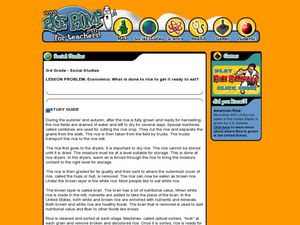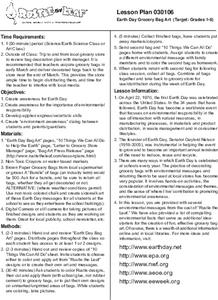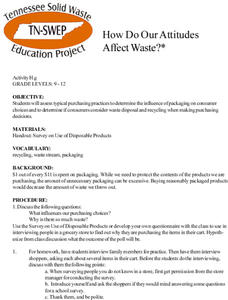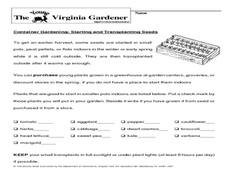Curated OER
Home Living / Daily Living: Shopping List 2
I've done this exercise with my special needs learners more times than I can count. They practice getting ready to shop at the grocery store by identifying items on their shopping list. They match grocery items to the proper department...
Curated OER
Grocery Store
Students explore food and grocery stores. In this lesson on foods, students are introduced to the food pyramid and healthy eating through a variety of center activities. Students have to opportunity to role-play working at a grocery store.
Curated OER
Grocery Store Bans Plastic Bags
Students participate in the paper vs. plastic bag debate, then read a news article about one grocery store that is banning plastic bags. In this current events instructional activity, the teacher introduces the news article with a debate...
Curated OER
Healthy Snacks Project Lesson
After learning why it is important to limit salt, fat, and sugar in their diets, divide your class into pairs or groups to complete this project. Each group will create two charts: unhealthy and healthy foods. They will cut out food...
It's About Time
Organizing a Store
When provided with multiple objects, how many ways can the class organize and display them based on predetermined factors? Assist class members with a handy activity—theoretically teaching them concepts to understand periodic...
Curated OER
4-H Food Science Activity Page- Life Skill- Healthy Lifestyle Choices
In this 4-H food science worksheet set, student investigate safe food handling procedures, create a recipe to share, identify the types of meats that are found at their local grocery store, and identify five dairy products. They complete...
Curated OER
Food Safety at the Grocery Store
Learners study the connection between food spoilage and temperature control. They determine the difference between expiration, sell-by, and use by date on food. They investigate food safety practices to look for when food shopping.
Curated OER
The Earth Day Groceries Project
Students research Earth Day and make bags to hand out on Earth Day to help promote taking care of the environment.
Curated OER
Food Without Oil
Young scholars discuss the oil crisis and how it affects the food they eat. In this food production instructional activity, students look at the foods sold in their grocery store and imagine which would leave if there was no oil to ship...
Curated OER
Economics: What is done to rice to get it ready to eat?
Third graders create a map showing the journey of rice from the field to the grocery store. In this agriculture instructional activity, 3rd graders discover and map the process of harvesting and preparing rice to be packaged and...
Curated OER
Earth Day Grocery Bag Art
Students decorate grocery bags with messages aimed at increasing environmental responsibility. They deliver the bags to local grocery stores in time for Earth Day.
Curated OER
A Visit to Price Chopper
Students visit the grocery store to purchase items to make trail mix which are connected to Kansas agriculture. They problem solve to determine which products to buy, then create, advertise and sell the trail mix to the student body...
Curated OER
Fur, Feathers and Fins
Students examine the stages between growing the animal and buying it at the grocery store. In food system lesson students study the role that animal products have on nutrition and study animal agriculture.
Virginia Department of Education
A Crystal Lab
Young chemists grow ionic crystals, metallic crystals, and supersaturated crystals in three different lab experiments. Observing these under a microscope allows pupils to compare the various structures.
Curated OER
Earth Day
Students practice addition and estimation. They use tens models to solve the problems related to grocery bags and Earth Day. Afterwards, they complete an activity sheet and draw a large grocery bag decorated with Earth Day messages.
Curated OER
Beanie Baby
Students will explain the importance of soybeans. In this science lesson, students participate in making a "beanie baby" necklace. Additionally, students observe their soybeans for germination and growth for 7-10 days. Students record...
Curated OER
Nutrition
Young scholars explore nutrition. In this science lesson plan, students identify and describe the main nutrients in our diets that are needed by the body as a source of energy.
Curated OER
An Introduction to 'Opae 'ula
Learners examine the 'opae 'ula. In this science lesson plan, students observe a live specimen and identify the major body parts. Learners construct habitat jars and observe the 'opae 'ula behaviors.
Curated OER
Limu Party
Students explore limu in their everyday lives. In this science lesson, students identify various uses of limu and discuss common household products that contain limu. Students participate in a limu party.
Discovery Education
Blueprint for Life
DNA is the code for all biological traits, both plant and animal. Using an exploratory lesson, learners begin to explore the concept of a biological code by decoding word puzzles. They then extract DNA from plant cells using detergent to...
Curated OER
How Do Our Attitudes Affect Waste?
High schoolers conduct a survey of society's typical purchasing practices to determine the influence of packaging on consumer choices and to determine if consumers consider waste disposal and recycling when making purchasing decisions.
Curated OER
Supermarket Science: The King Sooper Lab
Students read product labels, compare fat, sodium, and sugar contents of various food items. They work with a partner and often employ the assistance of the deli and bakery managers in a supermarket.
Curated OER
The Young Virginia Gardener: Container Gardening: Starting and Transplanting Seeds
In this gardening worksheet, students read a short passage about starting and transplanting seeds, then check names of plants they will put in their garden, noting whether they have started it from seed or purchased it from a store.
Curated OER
Slash Trash! Reducing, Reusing and Recycling Our Way to Zero Waste
The other "Three Rs" are covered in this lesson: reduce, reuse, and recycle. Over four weeks, conservationists collect data about waste in their own homes. They combine their findings with those of other students in order to analyze...

























